Abstract
During incomplete combustion of organic matter, nitro-polycyclic aromatic hydrocarbons (nitro-PAHs), are formed in a reaction that is catalyzed by a low pH. 2-Nitrofluorene (NF), a marker for nitro-PAHs, is metabolized in vivo by two different routes. After inhalation, potent mutagenic metabolites, hydroxylated nitrofluorenes (OH-NFs), are formed. The metabolites are distributed by systemic circulation. After oral administration, NF is reduced to the corresponding amine, a reaction mediated by the intestinal microflora. This metabolite is acetylated to 2-acetylaminofluorene (AAF), a potent carcinogen. Further ring-hydroxylation of AAF leads to detoxification and excretion. Induction of cytochrome P450s affects the metabolism, and more OH-NFs are formed. As a consequence, more mutagenic metabolites are found in the circulation. OH-NFs are excreted in the bile as, in terms of mutagenicity, totally harmless glucuronide conjugates. When these conjugates are excreted via the bile, intestinal beta-glucuronidase can liberate direct-acting mutagens in the intestine. Thus, inhalation of NF can lead to formation of potent mutagens in the intestine. NF is a direct-acting mutagen in bacterial assays and an initiator and promoter of the carcinogenic process, and gives rise to DNA adduct formation in laboratory animals.
Full text
PDF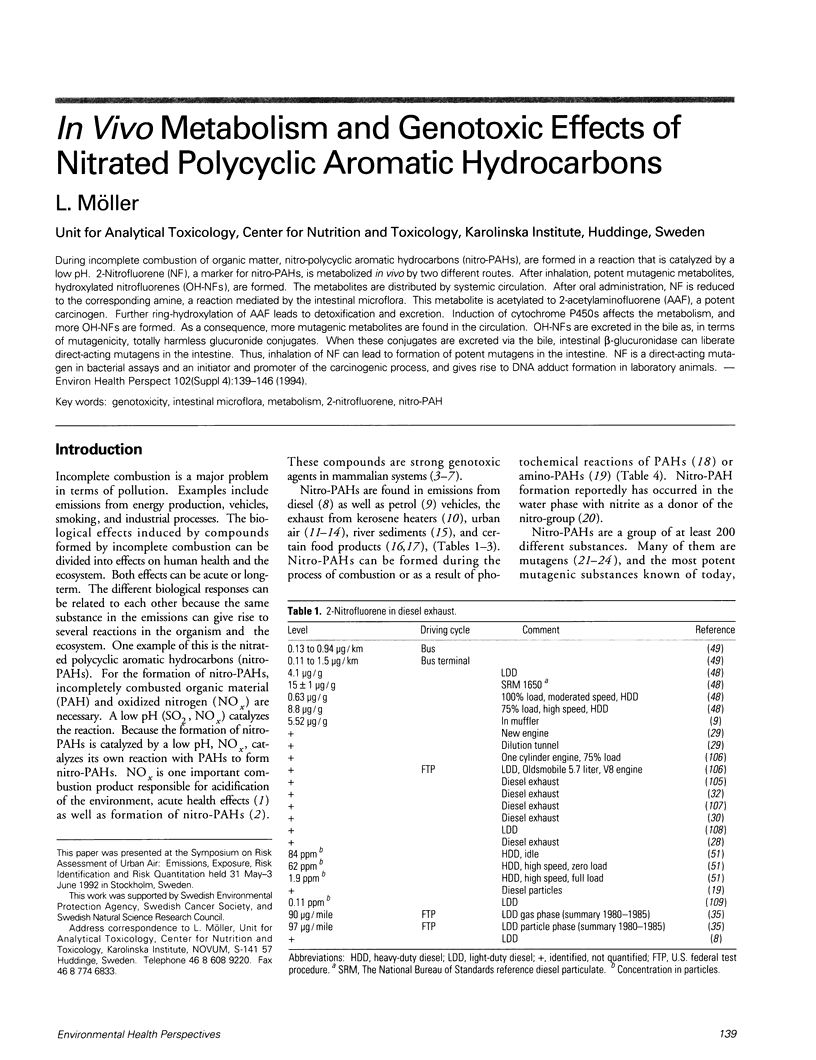

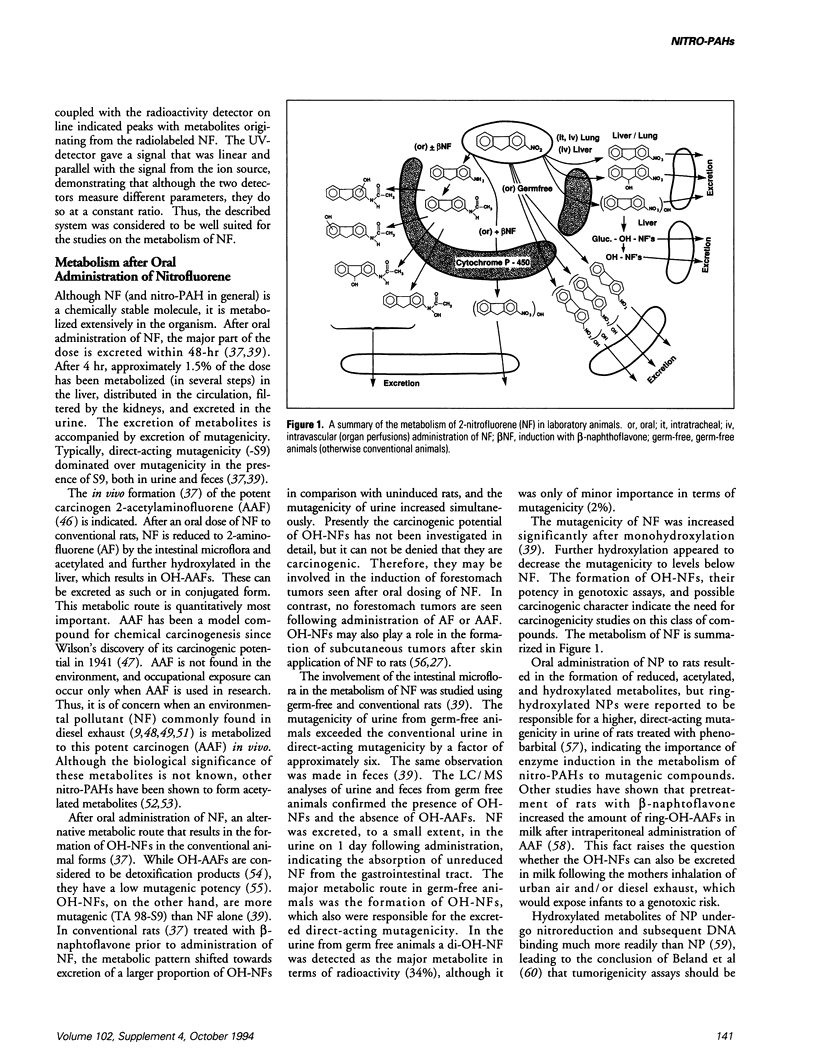
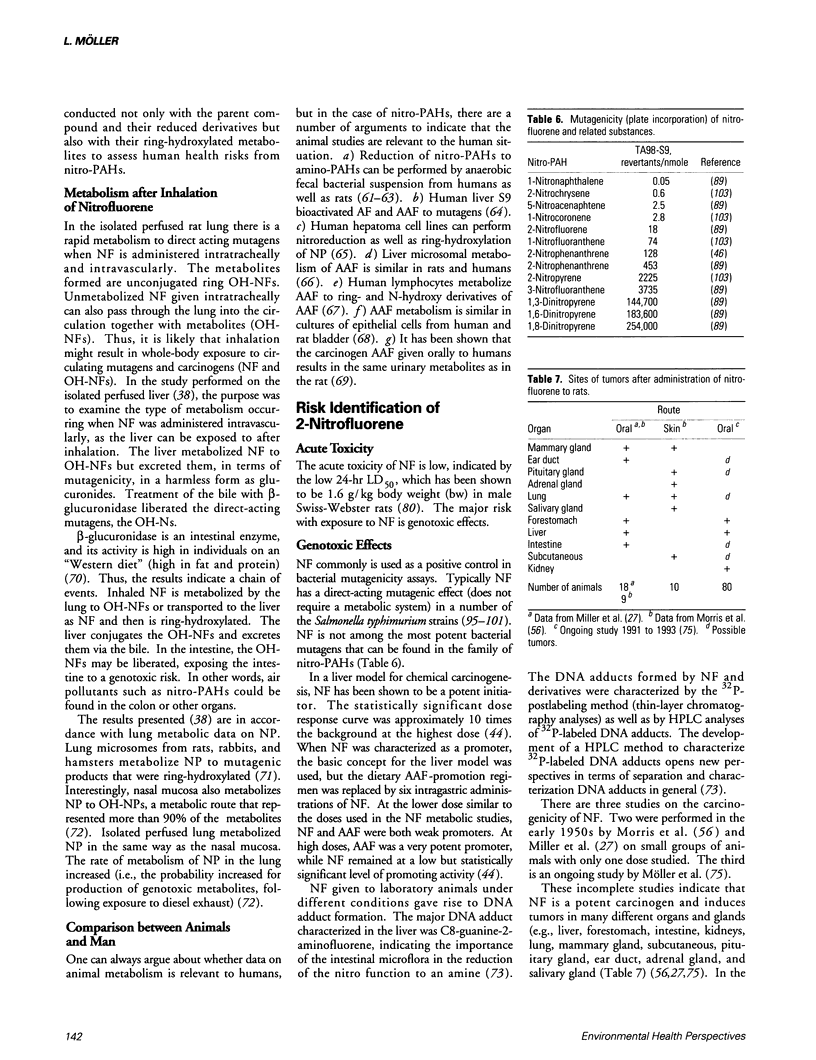

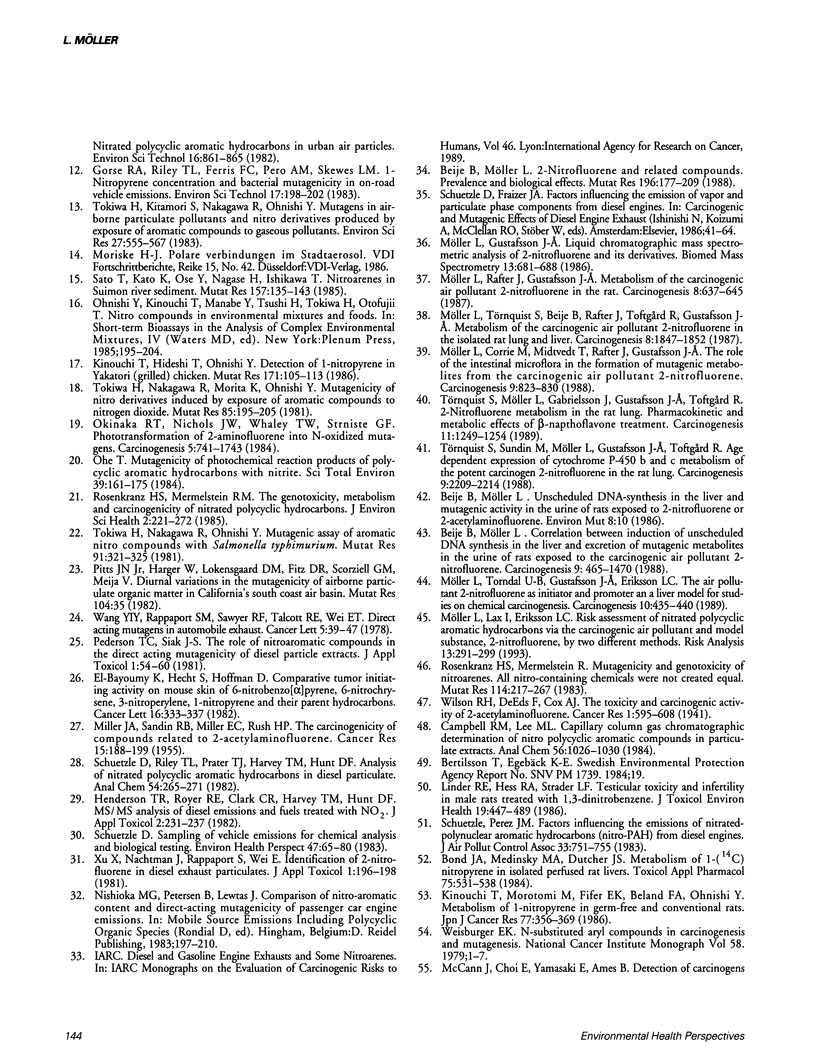

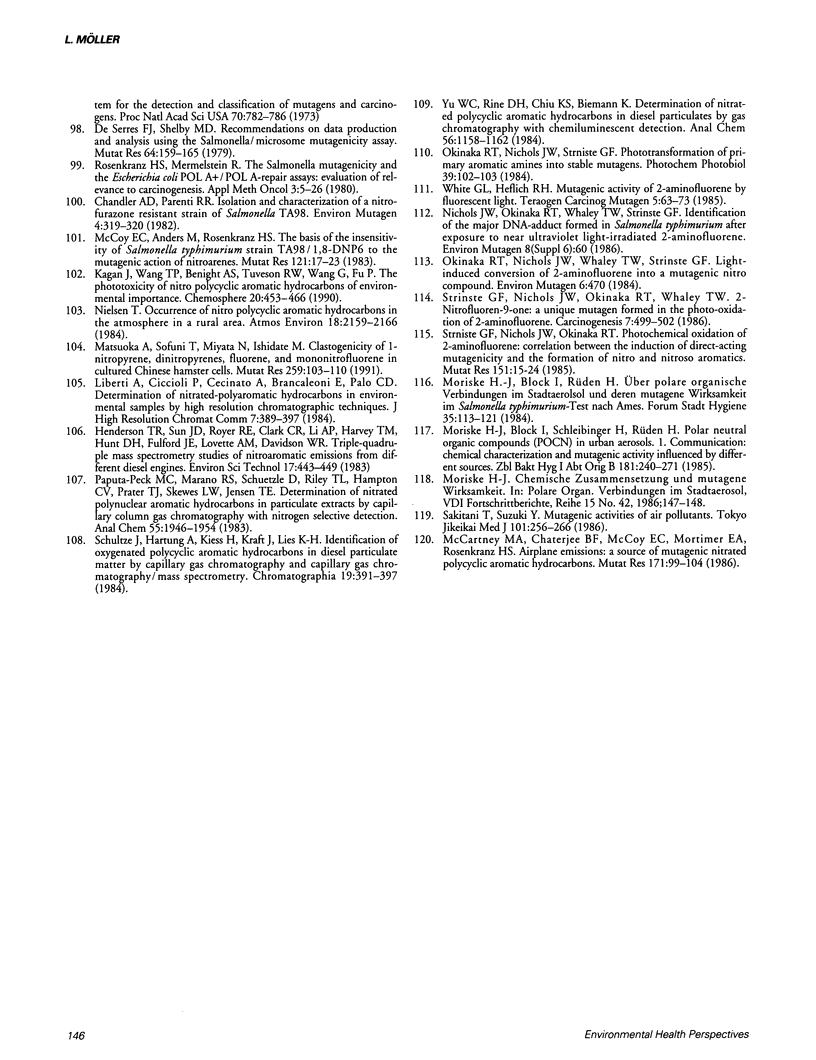
Selected References
These references are in PubMed. This may not be the complete list of references from this article.
- Banerjee T. S., Bhaumik G., Yu C. L., Swaminathan B., Giri A. K., Srivastava S., Bhattacharjee S. B. Evaluation of the genotoxicity of lac dye. Food Chem Toxicol. 1984 Aug;22(8):677–679. doi: 10.1016/0278-6915(84)90278-3. [DOI] [PubMed] [Google Scholar]
- Beije B., Möller L. 2-Nitrofluorene and related compounds: prevalence and biological effects. Mutat Res. 1988 Sep;196(2):177–209. doi: 10.1016/0165-1110(88)90019-x. [DOI] [PubMed] [Google Scholar]
- Beije B., Möller L. Correlation between induction of unscheduled DNA synthesis in the liver and excretion of mutagenic metabolites in the urine of rats exposed to the carcinogenic air pollutant 2-nitrofluorene. Carcinogenesis. 1988 Aug;9(8):1465–1470. doi: 10.1093/carcin/9.8.1465. [DOI] [PubMed] [Google Scholar]
- Belisario M. A., Carrano L., De Giulio A., Pecce R., Buonocore V. Effect of liver enzyme inducers on metabolite excretion in rats treated with 1-nitropyrene. Toxicol Lett. 1987 May;36(3):233–241. doi: 10.1016/0378-4274(87)90191-3. [DOI] [PubMed] [Google Scholar]
- Bond J. A., Medinsky M. A., Dutcher J. S. Metabolism of 1-[14C]nitropyrene in isolated perfused rat livers. Toxicol Appl Pharmacol. 1984 Sep 30;75(3):531–538. doi: 10.1016/0041-008x(84)90189-3. [DOI] [PubMed] [Google Scholar]
- Boobis A. R., Brodie M. J., McManus M. E., Staiano N., Thorgeirsson S. S., Davies D. S. Metabolism and mutagenic activation of 2-acetylaminofluorene by human liver and lung. Adv Exp Med Biol. 1981;136(Pt B):1193–1201. [PubMed] [Google Scholar]
- Cerniglia C. E., Howard P. C., Fu P. P., Franklin W. Metabolism of nitropolycyclic aromatic hydrocarbons by human intestinal microflora. Biochem Biophys Res Commun. 1984 Aug 30;123(1):262–270. doi: 10.1016/0006-291x(84)90407-8. [DOI] [PubMed] [Google Scholar]
- Danford N., Wilcox P., Parry J. M. The clastogenic activity of dinitropyrenes in a rat-liver epithelial cell line. Mutat Res. 1982 Nov;105(5):349–355. doi: 10.1016/0165-7992(82)90106-3. [DOI] [PubMed] [Google Scholar]
- Djurić Z., Fifer E. K., Howard P. C., Beland F. A. Oxidative microsomal metabolism of 1-nitropyrene and DNA-binding of oxidized metabolites following nitroreduction. Carcinogenesis. 1986 Jul;7(7):1073–1079. doi: 10.1093/carcin/7.7.1073. [DOI] [PubMed] [Google Scholar]
- Dybing E., Dahl J. E., Beland F. A., Thorgeirsson S. S. Formation of reactive 1-nitropyrene metabolites by lung microsomes and isolated lung cells. Cell Biol Toxicol. 1986 Sep;2(3):341–355. doi: 10.1007/BF00121850. [DOI] [PubMed] [Google Scholar]
- Eddy E. P., Howard P. C., McCoy G. D., Rosenkranz H. S. Mutagenicity, unscheduled DNA synthesis, and metabolism of 1-nitropyrene in the human hepatoma cell line HepG2. Cancer Res. 1987 Jun 15;47(12):3163–3168. [PubMed] [Google Scholar]
- El-Bayoumy K., Hecht S. S., Hoffmann D. Comparative tumor initiating activity on mouse skin of 6-nitrobenzo[a]pyrene, 6-nitrochrysene, 3-nitroperylene, 1-nitropyrene and their parent hydrocarbons. Cancer Lett. 1982 Sep;16(3):333–337. doi: 10.1016/0304-3835(82)90015-5. [DOI] [PubMed] [Google Scholar]
- El-Bayoumy K., Sharma C., Louis Y. M., Reddy B., Hecht S. S. The role of intestinal microflora in the metabolic reduction of 1-nitropyrene to 1-aminopyrene in conventional and germfree rats and in humans. Cancer Lett. 1983 Jul;19(3):311–316. doi: 10.1016/0304-3835(83)90100-3. [DOI] [PubMed] [Google Scholar]
- Gorbach S. L. The intestinal microflora and its colon cancer connection. Infection. 1982 Nov-Dec;10(6):379–384. doi: 10.1007/BF01642307. [DOI] [PubMed] [Google Scholar]
- Harris C., Namkung M. J., Juchau M. R. Regulation of intracellular glutathione in rat embryos and visceral yolk sacs and its effect on 2-nitrosofluorene-induced malformations in the whole embryo culture system. Toxicol Appl Pharmacol. 1987 Mar 30;88(1):141–152. doi: 10.1016/0041-008x(87)90278-x. [DOI] [PubMed] [Google Scholar]
- Henderson T. R., Royer R. E., Clark C. R., Harvey T. M., Hunt D. F. MS/MS analysis of diesel emissions and fuels treated with NO2. J Appl Toxicol. 1982 Oct;2(5):231–237. doi: 10.1002/jat.2550020504. [DOI] [PubMed] [Google Scholar]
- Howard P. C., Beland F. A., Cerniglia C. E. Reduction of the carcinogen 1-nitropyrene to 1-aminopyrene by rat intestinal bacteria. Carcinogenesis. 1983 Aug;4(8):985–990. doi: 10.1093/carcin/4.8.985. [DOI] [PubMed] [Google Scholar]
- Howard P. C., DeMarco G. J., Consolo M. C., McCoy G. D. Differing effects of chronic ethanol consumption by mice on liver microsomal metabolism of xenobiotics: 1-nitropyrene, nicotine, aniline, and N-nitrosopyrrolidine. Mol Toxicol. 1987 Apr-Sep;1(2-3):177–189. [PubMed] [Google Scholar]
- Ioannides C., Steele C. M. Hepatic microsomal mixed-function oxidase activity in ethanol-treated hamsters and its consequences on the bioactivation of aromatic amines to mutagens. Chem Biol Interact. 1986 Sep;59(2):129–139. doi: 10.1016/s0009-2797(86)80060-6. [DOI] [PubMed] [Google Scholar]
- Karpinsky G. E., Rosenkranz H. S. The anaerobe-mediated mutagenicity of 2-nitrofluorene and 2-aminofluorene for Salmonella typhimurium. Environ Mutagen. 1980;2(3):353–358. doi: 10.1002/em.2860020305. [DOI] [PubMed] [Google Scholar]
- Kincaid R. L., Miller W. J., Jensen L. S., Hampton D. L., Neathery M. W., Gentry R. P. Effect of high amounts of dietary zinc and age upon tissue zinc in young chicks. Poult Sci. 1976 Sep;55(5):1954–1957. doi: 10.3382/ps.0551954. [DOI] [PubMed] [Google Scholar]
- Kinouchi T., Morotomi M., Mutai M., Fifer E. K., Beland F. A., Ohnishi Y. Metabolism of 1-nitropyrene in germ-free and conventional rats. Jpn J Cancer Res. 1986 Apr;77(4):356–369. [PubMed] [Google Scholar]
- Kinouchi T., Tsutsui H., Ohnishi Y. Detection of 1-nitropyrene in yakitori (grilled chicken). Mutat Res. 1986 Aug-Sep;171(2-3):105–113. doi: 10.1016/0165-1218(86)90042-x. [DOI] [PubMed] [Google Scholar]
- Linder R. E., Hess R. A., Strader L. F. Testicular toxicity and infertility in male rats treated with 1,3-dinitrobenzene. J Toxicol Environ Health. 1986;19(4):477–489. doi: 10.1080/15287398609530946. [DOI] [PubMed] [Google Scholar]
- Lindvall T. Health effects of nitrogen dioxide and oxidants. Scand J Work Environ Health. 1985;11 (Suppl 3):10–28. [PubMed] [Google Scholar]
- MILLER J. A., SANDIN R. B., MILLER E. C., RUSCH H. P. The carcinogenicity of compounds related to 2-acetylaminofluorene. II. Variations in the bridges and the 2-substituent. Cancer Res. 1955 Mar;15(3):188–199. [PubMed] [Google Scholar]
- MORRIS H. P., DUBNIK C. S., JOHNSON J. M. Studies of the carcinogenic action in the rat of 2-nitro, 2-amino-, 2-acetylamino-, and 2-diacetylaminofluorene after ingestion and after painting. J Natl Cancer Inst. 1950 Jun;10(6):1201–1213. [PubMed] [Google Scholar]
- Malejka-Giganti D., Magat W. J., Adelmann A. M., Decker R. W. Metabolite profile in milk of lactating rats after treatment with a carcinogen, N-2-fluorenylacetamide. Drug Metab Dispos. 1987 Nov-Dec;15(6):760–766. [PubMed] [Google Scholar]
- Massaro M., McCartney M., Rozenkranz E. J., Anders M., McCoy E. C., Mermelstein R., Rosenkranz H. S. Evidence that nitroarene metabolites form mutagenic adducts with DNA-adenine as well as with DNA-guanine. Mutat Res. 1983 Dec;122(3-4):243–249. doi: 10.1016/0165-7992(83)90002-7. [DOI] [PubMed] [Google Scholar]
- Matsuoka A., Sofuni T., Miyata N., Ishidate M., Jr Clastogenicity of 1-nitropyrene, dinitropyrenes, fluorene and mononitrofluorenes in cultured Chinese hamster cells. Mutat Res. 1991 Jan;259(1):103–110. doi: 10.1016/0165-1218(91)90114-2. [DOI] [PubMed] [Google Scholar]
- McCann J., Choi E., Yamasaki E., Ames B. N. Detection of carcinogens as mutagens in the Salmonella/microsome test: assay of 300 chemicals. Proc Natl Acad Sci U S A. 1975 Dec;72(12):5135–5139. doi: 10.1073/pnas.72.12.5135. [DOI] [PMC free article] [PubMed] [Google Scholar]
- McCann J., Spingarn N. E., Kobori J., Ames B. N. Detection of carcinogens as mutagens: bacterial tester strains with R factor plasmids. Proc Natl Acad Sci U S A. 1975 Mar;72(3):979–983. doi: 10.1073/pnas.72.3.979. [DOI] [PMC free article] [PubMed] [Google Scholar]
- McCartney M. A., Chatterjee B. F., McCoy E. C., Mortimer E. A., Jr, Rosenkranz H. S. Airplane emissions: a source of mutagenic nitrated polycyclic aromatic hydrocarbons. Mutat Res. 1986 Aug-Sep;171(2-3):99–104. doi: 10.1016/0165-1218(86)90041-8. [DOI] [PubMed] [Google Scholar]
- McCoy E. C., Anders M., Rosenkranz H. S. The basis of the insensitivity of Salmonella typhimurium strain TA98/1,8-DNP6 to the mutagenic action of nitroarenes. Mutat Res. 1983 Jul;121(1):17–23. doi: 10.1016/0165-7992(83)90081-7. [DOI] [PubMed] [Google Scholar]
- McManus M. E., Trainor K. J., Morley A. A., Burgess W., Stupans I., Birkett D. J. Metabolism of 2-acetylaminofluorene in cultured human lymphocytes. Res Commun Chem Pathol Pharmacol. 1987 Mar;55(3):409–418. [PubMed] [Google Scholar]
- Moore B. P., Hicks R. M., Knowles M. A., Redgrave S. Metabolism and binding of benzo(a)pyrene and 2-acetylaminofluorene by short-term organ cultures of human and rat bladder. Cancer Res. 1982 Feb;42(2):642–648. [PubMed] [Google Scholar]
- Moriske H. J., Block I., Schleibinger H., Rüden H. Polare neutrale organische Verbindungen (POCN) im Stadtaerosol. 1. Mitteilung: Chemische Charakerisierung und mutagene Wirksamkeit in Abhängigkeit verschiedener Quelleinflüsse. Zentralbl Bakteriol Mikrobiol Hyg B. 1985 Dec;181(3-5):240–271. [PubMed] [Google Scholar]
- Möller L., Corrie M., Midtvedt T., Rafter J., Gustafsson J. A. The role of the intestinal microflora in the formation of mutagenic metabolites from the carcinogenic air pollutant 2-nitrofluorene. Carcinogenesis. 1988 May;9(5):823–830. doi: 10.1093/carcin/9.5.823. [DOI] [PubMed] [Google Scholar]
- Möller L., Gustafsson J. A. Liquid chromatographic-mass spectrometric analysis of 2-nitrofluorene and its derivatives. Biomed Environ Mass Spectrom. 1986 Dec;13(12):681–688. doi: 10.1002/bms.1200131208. [DOI] [PubMed] [Google Scholar]
- Möller L., Rafter J., Gustafsson J. A. Metabolism of the carcinogenic air pollutant 2-nitrofluorene in the rat. Carcinogenesis. 1987 May;8(5):637–645. doi: 10.1093/carcin/8.5.637. [DOI] [PubMed] [Google Scholar]
- Möller L., Torndal U. B., Eriksson L. C., Gustafsson J. A. The air pollutant 2-nitrofluorene as initiator and promoter in a liver model for chemical carcinogenesis. Carcinogenesis. 1989 Mar;10(3):435–440. doi: 10.1093/carcin/10.3.435. [DOI] [PubMed] [Google Scholar]
- Möller L., Törnquist S., Beije B., Rafter J., Toftgård R., Gustafsson J. A. Metabolism of the carcinogenic air pollutant 2-nitrofluorene in the isolated perfused rat lung and liver. Carcinogenesis. 1987 Dec;8(12):1847–1852. doi: 10.1093/carcin/8.12.1847. [DOI] [PubMed] [Google Scholar]
- Möller L., Zeisig M. DNA adduct formation after oral administration of 2-nitrofluorene and N-acetyl-2-aminofluorene, analyzed by 32P-TLC and 32P-HPLC. Carcinogenesis. 1993 Jan;14(1):53–59. doi: 10.1093/carcin/14.1.53. [DOI] [PubMed] [Google Scholar]
- Nachtman J. P., Wolff S. Activity of nitro-polynuclear aromatic hydrocarbons in the sister chromatid exchange assay with and without metabolic activation. Environ Mutagen. 1982;4(1):1–5. doi: 10.1002/em.2860040102. [DOI] [PubMed] [Google Scholar]
- Nachtman J. P., Wolff S. Activity of nitro-polynuclear aromatic hydrocarbons in the sister chromatid exchange assay with and without metabolic activation. Environ Mutagen. 1982;4(1):1–5. doi: 10.1002/em.2860040102. [DOI] [PubMed] [Google Scholar]
- Neal S. B., Probst G. S. Chemically-induced sister-chromatid exchange in vivo in bone marrow of Chinese hamsters. An evaluation of 24 compounds. Mutat Res. 1983 Feb;113(1):33–43. doi: 10.1016/0165-1161(83)90239-x. [DOI] [PubMed] [Google Scholar]
- Ohe T. Mutagenicity of photochemical reaction products of polycyclic aromatic hydrocarbons with nitrite. Sci Total Environ. 1984 Oct;39(1-2):161–175. doi: 10.1016/0048-9697(84)90033-0. [DOI] [PubMed] [Google Scholar]
- Ohe T. Studies on comparative decomposition rate by rat liver homogenate and on micronucleus test of nitrated polycyclic aromatic hydrocarbons. Bull Environ Contam Toxicol. 1985 May;34(5):715–721. doi: 10.1007/BF01609798. [DOI] [PubMed] [Google Scholar]
- Okinaka R. T., Nickols J. W., Whaley T. W., Strniste G. F. Phototransformation of 2-aminofluorene into N-oxidized mutagens. Carcinogenesis. 1984 Dec;5(12):1741–1743. doi: 10.1093/carcin/5.12.1741. [DOI] [PubMed] [Google Scholar]
- Pederson T. C., Siak J. S. The role of nitroaromatic compounds in the direct-acting mutagenicity of diesel particle extracts. J Appl Toxicol. 1981 Apr;1(2):54–60. doi: 10.1002/jat.2550010203. [DOI] [PubMed] [Google Scholar]
- Pitts J. N., Jr, Harger W., Lokensgard D. M., Fitz D. R., Scorziell G. M., Mejia V. Diurnal variations in the mutagenicity of airborne particulate organic matter in California's south coast air basin. Mutat Res. 1982 Apr;104(1-3):35–41. doi: 10.1016/0165-7992(82)90117-8. [DOI] [PubMed] [Google Scholar]
- Rosenkranz H. S., McCoy E. C., Frierson M., Klopman G. The role of DNA sequence and structure of the electrophile on the mutagenicity of nitroarenes and arylamine derivatives. Environ Mutagen. 1985;7(5):645–653. doi: 10.1002/em.2860070504. [DOI] [PubMed] [Google Scholar]
- Rosenkranz H. S., Mermelstein R. Mutagenicity and genotoxicity of nitroarenes. All nitro-containing chemicals were not created equal. Mutat Res. 1983 Apr;114(3):217–267. doi: 10.1016/0165-1110(83)90034-9. [DOI] [PubMed] [Google Scholar]
- Sato T., Kato K., Ose Y., Nagase H., Ishikawa T. Nitroarenes in Suimon River sediment. Mutat Res. 1985 Aug-Sep;157(2-3):135–143. doi: 10.1016/0165-1218(85)90108-9. [DOI] [PubMed] [Google Scholar]
- Schuetzle D. Sampling of vehicle emissions for chemical analysis and biological testing. Environ Health Perspect. 1983 Jan;47:65–80. doi: 10.1289/ehp.834765. [DOI] [PMC free article] [PubMed] [Google Scholar]
- Simmon V. F., Rosenkranz H. S., Zeiger E., Poirier L. A. Mutagenic activity of chemical carcinogens and related compounds in the intraperitoneal host-mediated assay. J Natl Cancer Inst. 1979 Apr;62(4):911–918. [PubMed] [Google Scholar]
- Strniste G. F., Nickols J. W., Okinaka R. T. Photochemical oxidation of 2-aminofluorene: correlation between the induction of direct-acting mutagenicity and the formation of nitro and nitroso aromatics. Mutat Res. 1985 Aug;151(1):15–24. doi: 10.1016/0027-5107(85)90177-0. [DOI] [PubMed] [Google Scholar]
- Strniste G. F., Nickols J. W., Okinaka R. T., Whaley T. W. 2-Nitrofluoren-9-one: a unique mutagen formed in the photo-oxidation of 2-aminofluorene. Carcinogenesis. 1986 Mar;7(3):499–502. doi: 10.1093/carcin/7.3.499. [DOI] [PubMed] [Google Scholar]
- Tokiwa H., Nakagawa R., Horikawa K. Mutagenic/carcinogenic agents in indoor pollutants; the dinitropyrenes generated by kerosene heaters and fuel gas and liquefied petroleum gas burners. Mutat Res. 1985 Jul;157(1):39–47. doi: 10.1016/0165-1218(85)90047-3. [DOI] [PubMed] [Google Scholar]
- Tokiwa H., Nakagawa R., Morita K., Ohnishi Y. Mutagenicity of nitro derivatives induced by exposure of aromatic compounds to nitrogen dioxide. Mutat Res. 1981 Aug;85(4):195–205. doi: 10.1016/0165-1161(81)90036-4. [DOI] [PubMed] [Google Scholar]
- Tokiwa H., Nakagawa R., Morita K., Ohnishi Y. Mutagenicity of nitro derivatives induced by exposure of aromatic compounds to nitrogen dioxide. Mutat Res. 1981 Aug;85(4):195–205. doi: 10.1016/0165-1161(81)90036-4. [DOI] [PubMed] [Google Scholar]
- Tokiwa H., Nakagawa R., Ohnishi Y. Mutagenic assay of aromatic nitro compounds with Salmonella typhimurium. Mutat Res. 1981 Jul-Sep;91(4-5):321–325. doi: 10.1016/0165-7992(81)90008-7. [DOI] [PubMed] [Google Scholar]
- Tucker J. D., Ong T. Induction of sister-chromatid exchanges and chromosome aberrations in human peripheral lymphocytes by 2,4,7-trinitro-9-fluorenone. Mutat Res. 1984 Nov-Dec;138(2-3):181–184. doi: 10.1016/0165-1218(84)90042-9. [DOI] [PubMed] [Google Scholar]
- Törnquist S., Möller L., Gabrielsson J., Gustafsson J. A., Toftgård R. 2-Nitrofluorene metabolism in the rat lung. Pharmacokinetic and metabolic effects of beta-naphthoflavone treatment. Carcinogenesis. 1990 Aug;11(8):1249–1254. doi: 10.1093/carcin/11.8.1249. [DOI] [PubMed] [Google Scholar]
- Törnquist S., Sundin M., Möller L., Gustafsson J. A., Toftgård R. Age dependent expression of cytochrome P-450b and metabolism of the potent carcinogen 2-nitrofluorene in the rat lung. Carcinogenesis. 1988 Dec;9(12):2209–2214. doi: 10.1093/carcin/9.12.2209. [DOI] [PubMed] [Google Scholar]
- WEISBURGER J. H., GRANTHAM P. H., VANHORN E., STEIGBIGEL N. H., RALL D. P., WEISBURGER E. K. ACTIVATION AND DETOXIFICATION OF N-2-FLUORENYLACETAMIDE IN MAN. Cancer Res. 1964 Apr;24:475–479. [PubMed] [Google Scholar]
- Wang Y. Y., Rappaport S. M., Sawyer R. F., Talcott R. E., Wei E. T. Direct-acting mutagens in automobile exhaust. Cancer Lett. 1978 Jul;5(1):39–47. doi: 10.1016/s0304-3835(78)80009-3. [DOI] [PubMed] [Google Scholar]
- White G. L., Heflich R. H. Mutagenic activation of 2-aminofluorene by fluorescent light. Teratog Carcinog Mutagen. 1985;5(1):63–73. doi: 10.1002/tcm.1770050108. [DOI] [PubMed] [Google Scholar]
- Xu X. B., Nachtman J. P., Rappaport S. M., Wei E. T., Lewis S., Burlingame A. L. Identification of 2-nitrofluorene in diesel exhaust particulates. J Appl Toxicol. 1981 Jun;1(3):196–198. doi: 10.1002/jat.2550010312. [DOI] [PubMed] [Google Scholar]
- Yu W. C., Fine D. H., Chiu K. S., Biemann K. Determination of nitrated polycyclic aromatic hydrocarbons in diesel particulates by gas chromatography with chemiluminescent detection. Anal Chem. 1984 Jun;56(7):1158–1162. doi: 10.1021/ac00271a024. [DOI] [PubMed] [Google Scholar]


